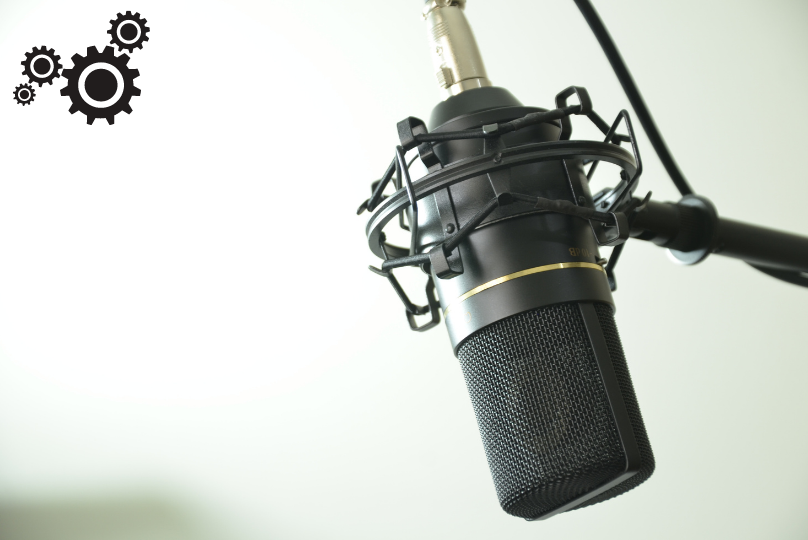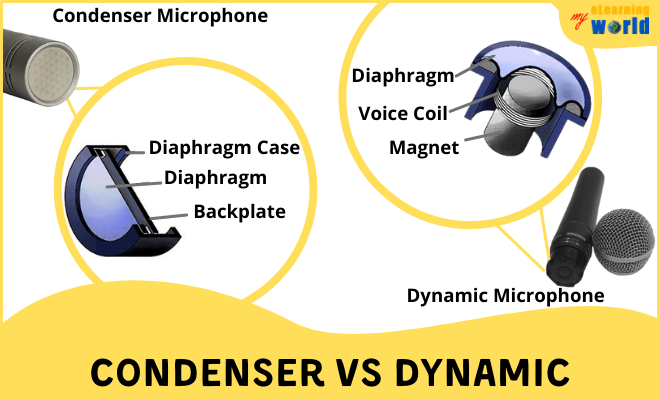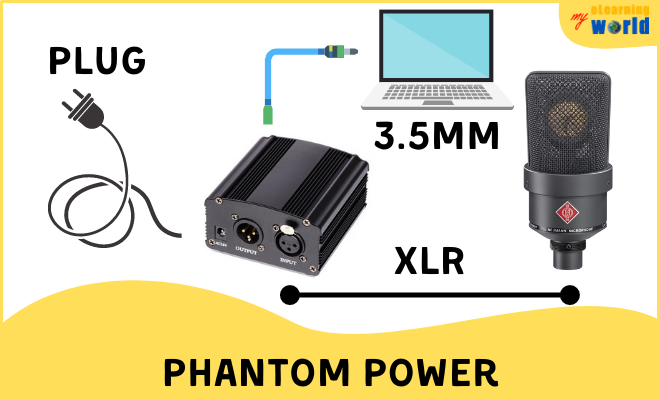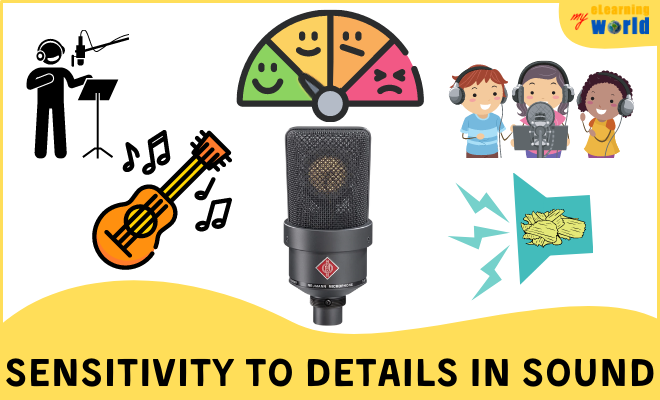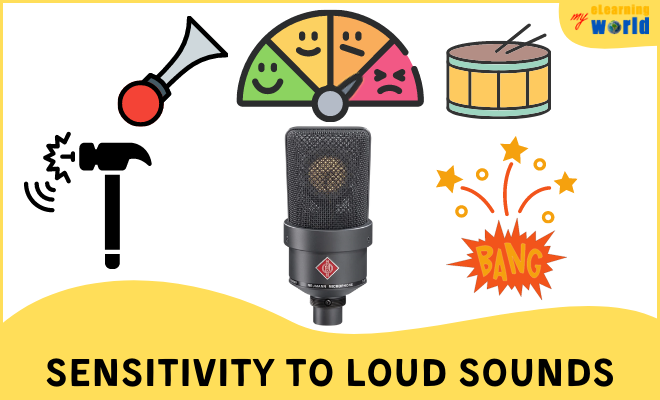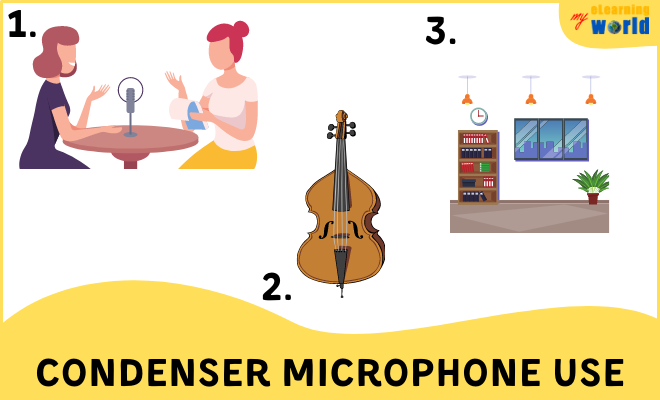What is a condenser microphone? And how do condenser microphones work?
If you’re setting up a home studio or doing any sort of audio work, these are just a couple of questions you might have.
In the recording industry, the condenser microphone stands out as the top choice of voice-over artists, major studios, producers, vocalists, and other industry professionals – but why?
What makes condenser microphones such a popular option?
Should you be using condenser microphones for your own recording projects?
Read on to learn more about what a condenser mic is, the types of condenser microphones, why you might want to use one, and even why you might not want to use one.
What is a Condenser Microphone?
In general, there are two types of microphones used today: condenser and dynamic.
Condenser microphones are usually used to pick up detailed sound in a studio environment where audio can be tightly controlled while a dynamic mic is often used in a live setting where volume levels might be higher.
In other words, condenser microphones are a staple in recording studios.
The reason a condenser mic is used for studio work is that it is designed to pick up subtle, nuanced sounds instead of loud, abrasive sounds.
This allows them to capture a more crisp, clear audio signal and reproduce sound that is natural and warm.
I’ll go into more detail about how these microphones work below along with a description of their components, but just know that they are geared toward high-quality recording that produces a lot of clarity and character.
Take a Deeper Dive
Want to know more about the differences between the condenser and dynamic mics? Take a look at this video from Podcastage on YouTube that explains it:
Types of Condenser Microphones
Although there are a number of different types of microphones in general, there are really only two types of condenser microphones: large-diaphragm and small-diaphragm. Each has a different characteristic in sound capture, and each is used in a different way during recording.
Large-Diaphragm Condenser Microphones

A large-diaphragm condenser mic will usually be fixed in a stationary position in a recording booth.
Large diaphragm condenser microphones are often used to pick up the richness and fullness of low-end sounds as they produce a widening effect that really fills and audio space in the mix.
Small-Diaphragm Condenser Microphones

In most cases, units using this configuration will situate the diaphragm in a front-facing position and the audio source will direct its energy toward the top of the microphone.
Small diaphragm condenser microphones may be handheld, but they are often used for recording from a desktop position or in a mounted position in a studio.
In addition, small diaphragm mics are excellent for picking up transients and other high-end sounds.
Take a Deeper Dive
You can learn more about the differences between large-diaphragm and small-diaphragm condenser mics by checking out this video below by ProAudioLand:
The Components of Condenser Microphones
Condenser microphones are fairly simple in terms of their design, but the component interaction and science inside them are a bit complex.
Below is a general list of components found in condenser microphones and their functions:
Backplate

A capacitor functions by storing electrical energy between two components. The backplate in a condenser microphone serves as one of these components.
Capsule

You may also hear some people use “capsule” and “diaphragm” interchangeably, despite this not being technically correct.
Diaphragm
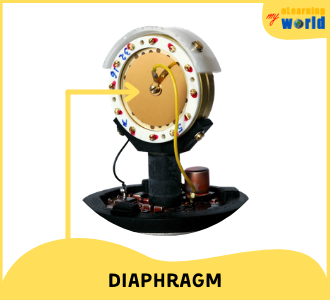
In a capacitor sense, the diaphragm acts as the component opposite the backplate in the storage of energy in an electrical field.
Impedance Converter
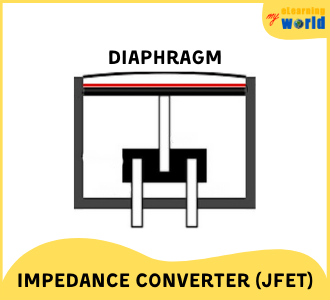
Power Supply
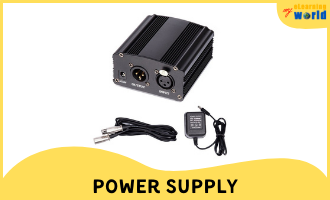
Take a Deeper Dive
Want to see a detailed view of the components? Matthew McGlynn of Roswell Pro Audio breaks down each piece and works through how the components function and interact.
How Does a Condenser Microphone Work?
The capsule of a condenser microphone contains a membrane (diaphragm) that is coated in a material like gold to conduct electricity. This membrane is set in close proximity to a metal backplate.
When sound waves hit the diaphragm, it vibrates in close proximity to the backplate.
In a nutshell, the microphone is taking the physical changes in air pressure (sound waves) that take place as the membrane vibrates against the metal backplate in the capsule.
The difference in pressure between the diaphragm and the backplate (capacitance) is recorded via voltage that is amplified and translated to audio sound wave images in a recording device or recording software.
Take a Deeper Dive
You already know the components of condenser microphones and how they interact, but sometimes it pays to see the technology in action. Check out this YouTube video to see Gary Boss from Audio Technica answer the question.
All microphones have similarities and differences. To take a closer look at how omnidirectional microphones work click here.
Condenser Microphone Power Requirements
Condenser mics require external power in order to operate. This is largely because, while it outputs a lot of voltage, it does not produce a current relative to the power needs of recording. To combat this, an impedance converter is typically required in order to boost the signal and make it powerful enough for modern recording equipment.
Dedicated Power Supply Unit
In order to get this power, condenser microphones need to either be attached to a dedicated power supply or a phantom power supply.
In the past, dedicated power supply units were used to power individual condenser microphones during recording, but these supply units were cumbersome and made it difficult to record multiple devices at once.
Some recording professionals may still opt for a dedicated power supply for certain models, but for the most part, phantom power is the way that most of them receive power.
Phantom Power
Phantom power is power that is supplied by another peace of gear through a non-power line. In the case of condenser mics, phantom power comes from either an XLR cable or a USB cable depending on the setup. Phantom power is supplied at 48 volts of direct current (DC), and this type of power is sometimes referred to as R48 power. Phantom power eliminates the need for a dedicated power supply, and it also allows microphones to be used across many different pieces of recording equipment by simply plugging the device in.
Advantages and Disadvantages of Condenser Microphones
While condenser mics are often the choice for studio work and recording sessions that require a great deal of clarity and nuance, they aren’t suited for every situation.
Below are some advantages and disadvantages of using condenser microphones:
Advantages
Condenser capsules are very sensitive to sound, so they can capture subtle details and rich tones that may be missed by other types of microphones. This can be a great advantage when recording vocals and voice-over work, but it can also benefit acoustic instrument recording requiring a specific focus on tonality.
A condenser mic is also ideal for group sound capture when used with an omnidirectional polar pattern. Since they are meant to be stationary and are not usually held by hand, you can place a condenser microphone in a large recording room or vocal booth to capture a wide array of crisp sounds from all around.
This means that you can record more with one device and cut down on post-processing time without having to deal with multiple tracks.
Disadvantages
Perhaps the biggest disadvantage to using a condenser mic is actually one of its advantages: sensitivity to sound.
Because their capsules are very sensitive by design, they can become easily overwhelmed by loud sounds, leading to distortion in recording. This is especially true when using a condenser microphone to record things like drums or amplified signals.
To add to the volume issue, the diaphragm of a condenser mic can also be easily damaged due to extreme volume levels. The diaphragm is fragile, meaning condenser microphones are also prone to damage when not handled with care. A simple drop or even a very hard bump could potentially damage the relationship between the diaphragm and the backplate.
They also tend to be at a disadvantage when capturing sound in a live environment. This includes situations when speaking before a crowd, singing during a live performance or when providing narration in a play-by-play situation where a handheld mic is required. Because of the sensitive nature of a condenser microphone, the unit will likely pick up background noise, but it can also pick up noises created when handling the device, potentially ruining a recording.
What Are Condenser Mics Mostly Used For?
By and large, condenser microphones are used almost exclusively for recording the human voice. This is because they pick up rich detail and reproduce natural tones very well compared to other types of mics, and the human voice produces sound at tolerable volumes for most recording situations.
This is not to say that condenser microphones must be used for quiet voices, but they generally perform better and capture clarity in greater detail from quieter sources.
Condenser microphones are also used for recording acoustic instruments. Things like acoustic guitars and other stringed instruments often shine more brightly when recorded using a condenser mic, and even some light percussive instruments can be recorded using them.
Recording ambient room noise is also a job for condenser microphones because of their sensitivity. This is often done during film production to pad audio recorded on a sound stage for a more natural presentation.
Finding the Right Condenser Microphone
Condenser mics come in a variety of price ranges, and top-quality condenser mics can run into the thousands of dollars. What’s important to keep in mind is that you don’t have to spend a fortune to get a good device, but you do need to think about your recording needs.
If you’re podcasting, recording general voice-over work or you’re recording a YouTube video, a USB condenser microphone will likely serve you just fine. In fact, you can check out more information about some of the best mics for YouTube to learn about some exciting options and recording solutions.
If, on the other hand, you’re recording vocal performances for a million-dollar record in a professional studio, you’re probably going to do better with a large-diaphragm condenser mic that utilizes an XLR output and maybe even a dedicated power supply.
Useful Resources
- How Does a Microphone Work
- 10+ Statements on Condenser Microphones Versus Dynamic Mics
- How to make a DIY microphone pop filter
- How do wireless microphones work?
A Final Word on Condenser Microphones
So, just what is a condenser microphone? It is the go-to option for recording sounds that really need to showcase subtle detail and clarity.
Condenser microphones offer a lot of versatility when used correctly, and deliver high-quality results without much effort.
Treat your device with care, utilize it properly and it will last you for decades to come.
Have any questions about condenser microphones? Leave a comment below and we’ll help you out.

